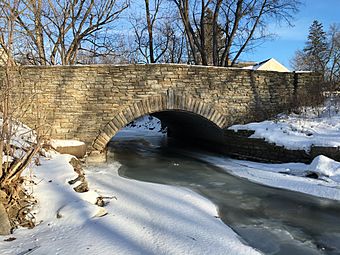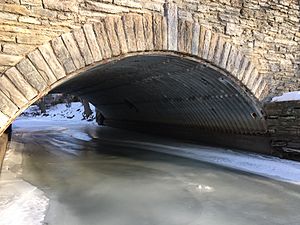Bridge No. 90646 facts for kids
Quick facts for kids |
|
|
Bridge No. 90646
|
|

Bridge No. 90646 viewed from the west
|
|
| Location | 4400 W. 50th St., Edina, Minnesota |
|---|---|
| Area | 0.02 acres (0.0081 ha) |
| Built | 1937 |
| Built by | Works Progress Administration |
| Architect | Lyle Culvert & Pipe Company |
| MPS | Iron & Steel Bridges in MN, 1873-1945 |
| NRHP reference No. | 15001016 |
| Added to NRHP | February 2, 2016 |
Bridge No. 90646, also known as the Wooddale Avenue Bridge, is a special kind of bridge. It's a multi-plate steel arch bridge. This means it's made from many strong steel plates that form an arch shape. The bridge carries a local street over Minnehaha Creek in Edina, Minnesota, United States.
This bridge is important because it was added to the National Register of Historic Places in February 2016. This list includes places that are important to American history.
Contents
What Makes This Bridge Special?
The bridge is about 21 feet (6.4 m) (6.4 meters) long. It stretches 18 feet (5.5 m) (5.5 meters) across the creek. The bridge is also quite wide, at 40.4 feet (12.3 m) (12.3 meters).
The outside of the bridge is covered with a type of stone called Platteville limestone. This stone gives the bridge a nice, natural look.
Why Was This Bridge Built?
The area around the bridge used to be a large farm. This was the George W. Baird farm. In the 1920s, parts of the farm were sold. New homes and buildings were planned.
In 1922, the Edina Country Club housing area was laid out. This was just north of the bridge. The Edina Country Club itself opened in 1923. As more people moved in, traffic grew very busy.
The old bridge could not handle all the cars. So, in 1937, the city of Edina decided to build a new one.
How Was the Bridge Built?
On March 8, 1937, the Edina City Council chose a company to build the new bridge. This company was Lyle Culvert & Pipe Company. They planned to build an Armco multi-plate arch bridge.
At first, the bridge was going to have a rough stone look. This style was called WPA Rustic. It was meant to look natural and blend in.
However, in July 1937, the design changed. Instead of rough stone, they decided to use limestone. This was done to match a nearby church, St. Stephen's Episcopal Church, which also had limestone. The change did not slow down the building. The bridge was mostly finished by August 1937. A city newsletter in September 1937 showed the completed bridge.
The Special Design of the Bridge
The idea for the multi-plate arch bridge came out in 1931. It was created by the Armco Culvert Manufacturer's Association. These bridges are made from strong, curved steel plates. The plates are coated with zinc to prevent rust. This is called galvanized steel.
The plates have ridges, like a washboard. These ridges are about 6 inches (150 mm) (15 cm) wide and 1.5 inches (38 mm) (3.8 cm) deep. These ridges make the bridge very strong. The plates are put together right at the building site to form the arch.
A Strong and Unique Bridge
This type of multi-plate arch bridge was very popular in the 1930s. It was a good choice for shorter bridges. It was also easier to build than some other bridges made of concrete.
The Works Progress Administration (WPA) helped build this bridge. The WPA was a government program during the Great Depression. It helped people find jobs. Building this bridge needed many workers for the stone parts. So, the WPA was able to employ many people.
Many multi-plate arch bridges were built in Minnesota during the Great Depression. But today, they are becoming rare. In 1988, there were 35 of these bridges left in the state. By 2014, only eight remained. This makes Bridge No. 90646 even more special.





